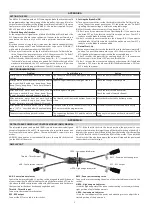
28
29
Accelerated flight
Power induced oscillations
It is recommended to use the accelerator when flying against the wind or in zones with
descending air. Due to a decreased angle of attack, the canopy may collapse easier than
when set at the normal position. The pilot must remember that the higher the speed, the
more dynamic the collapse response or symmetric closing will be.
It is recommended to use the accelerator when flying against the wind or in zones
with descending air. Due to a decreased angle of attack, the canopy may collapse
easier than when set at the normal position. The pilot must remember that the higher
the speed, the more dynamic the collapse response or symmetric closing will be.
- Exercise the use of the accelerator during calm conditions.
- Be cautious flying accelerated in difficult and turbulent conditions.
- Remember: The higher the speed the higher the descent rate.
- Check always on all accelerator parts for good function and signs of wear.
Active flying
In turbulent conditions it is not recommended to fly the power glider with full speed, cause
the Flexus 2 is than more sensitive to deformation and closing. The pilot must remember
that the higher the speed, the more dynamic the collapse response or symmetric closing
will be.
Landing with paratrike
The points earlier mentioned are valid, in principle.
Landing with paramotor
Always choose a secure and clean landing side with lots of space, great distance to
natural obstacles and is not under the influence of turbulent air.
- Leave trimmers 2 cm open to make landing easier.
- The final approach stage must be done in straight line upwind.
- Switch off the engine.
- With less than 30m above ground avoid steer turns, they may result in dangerous
pendulous movements and the pilot could crash to the ground with high velocity.
- Before landing get up in your harness with the weight against the chest strap, especially
in turbulent conditions.
- Fly with hands up, without brakes, until more or less 1m over ground. In turbulent
conditions fly active until the end. Than apply slowly and progressively the brakes to
reduce velocity until you can almost without speed land on the ground.
- Always adapt your landing on space, circumstances and wind.
- If the wind is strong and you feel it might be possible been dragged or uplifted after
landing, pull symmetrically the B risers. This movement kills the glider fast and controlled
and avoids a re-inflation or that the glider turns into a great sail. After killing the glider
pull him back to you using the B risers.
For takeoff and landing with a trike you need a larger airstrip.
















































